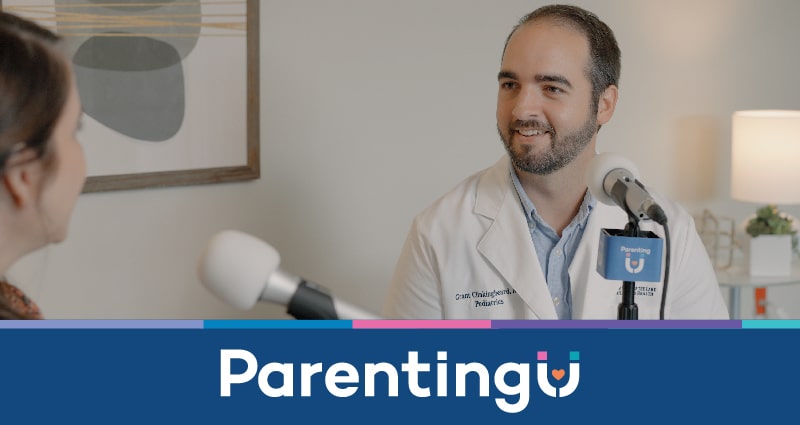Buckle up! The road to independence for teens often includes that first turn behind the wheel and eventually their own driver’s license.
Teen driving isn’t just about handling the vehicle and always wearing a seatbelt – although both are very important! In this ParentingU podcast episode, Grant Clinkingbeard, MD, pediatrician with Our Lady of the Lake Children’s Health in Covington, shares his advice for parents to support new drivers on the delicate balance of freedom and safety.
Start Driving Safety Conversations Early
Learning to be a safe driver starts well before a teen gets behind the wheel.
“Safe driving is something we can promote as parents as soon as our kids are old enough to understand,” Dr. Clinkingbeard says. “They’re watching us. They’re seeing us drive. Even if they’re not thinking about being a driver one day, they’re learning.”
When teens are first learning to drive they may be a little nervous, and parents staying cool, calm and collected can be a challenge.
In Louisiana, drivers start with temporary instructional permit – a TIP card – to get into driver’s ed. Dr. Clinkingbeard recommends parents make a plan to help their soon-to-be drivers get comfortable. Just as a parent of a toddler would narrate a task to teach them, add commentary as you drive a normal route. And do that several times. Point out speeders going too fast
The next step – sit together in the car, with your teen in the driver’s seat.
“Never leave the driveway and go over everything,” Dr. Clinkingbeard says. Get them comfortable with the buttons and lights, adjusting the mirrors, seatbelt, seat height and steering wheel.
Next, once they have that TIP card, let your child drive that same route as you narrate in the same way you did when you drove it.
Finally, Dr. Clinkingbeard’s last step “Just take some deep breaths and try to keep calm.” When faced with the inevitable scary moments as your driver is still learning, Dr. Clinkingbeard offers some language parents can use to help.
“Find the next place you can pull the car over and say, ‘We’re going to take a few deep breaths. You did fine. Try this the next time that happens,’” he says. “Don’t expect them to keep driving stressed, anxious or heightened.”
Safety for Non-Drivers: Back Seat Until 13
For tweens who are not yet driving but dream of being in the front seat at all, Dr. Clinkingbeard clues us in to the state law: passengers need to be in the backseat until they’re 13 years old, a law that changed in 2019.
“Honestly, as adults, we may choose to sit in the passenger seat, but if you’re not driving we should be sitting in the back,” Dr. Clinkingbeard says. It’s the safest place in the event of a crash, away from the most likely points of impact.
Avoiding Distractions – Including Phones
Putting phones away while driving is key to being safe, especially for new drivers. Modeling the behavior you want to see is a fundamental parenting strategy, and that includes being a safe driver.
“Maybe it’s something we do as a family and say we’re going to all agree to put our phones away in the car,” Dr. Clinkingbeard says. “It doesn’t matter if we’re in the car together. It doesn’t matter if we’re separate. We’re all going to put them away, make a family pact.”
But it’s not just phones that can be a distraction.
The TIP card is the first step in a graduated driver’s license requirement, and it includes certain restrictions to reduce those distractions, including when new drivers can be on the road. Teens can also be distracted by friends and peers, so that might be a rule set by parents to wait until your young driver is more confident before they can carry teen passengers.
The Big Question: Tracking Apps
New technology allows parents to track their teen’s driving patterns including speed and location. While using such tracking tech is a personal family choice, Dr. Clinkingbeard says he is OK with them.
“I think they’re good and allow you to check in without your teen needing to text while driving,” he says.
But the kicker: it can’t be a secret. “You cannot hide something in your kid’s car, tracking them without telling them,” he says. “Truth and honesty is so, so important to any relationship, and you can’t expect a kid to be honest with you if you’re sneaking behind them.”
Dr. Clinkingbeard recommends families consider making tracking a part of the family contract or agreement to be see each other’s locations and make it part of the privilege of driving.
Risk Avoidance While Gaining Independence
Teens need to understand the risks of driving – and why they should avoid speeding, distracted driving and other risky behavior.
“If I can change one thing about teenagers and help them live a long, happy and fruitful life, it’s by avoiding accidents when they’re young,” Dr. Clinkingbeard says. Teens brains are not fully developed, which impacts their decision-making ability and they may not be as likely to think about risks in a long-term way. Peer pressure also comes into play.
“A teenager may know, ‘I shouldn’t ride with someone who’s been drinking,’ but in the moment the impulsive decision may speak louder,” Dr. Clinkingbeard says. He encourages parents to tell their children to “listen to the part of your brain that’s saying , ‘Hey this isn’t a good idea.’”
Building Trust and Communication
Dr. Clinkingbeard recommends a “text me” approach to give kids a way out of sticky situations. An automatic text or safe word can be a key to let you know it’s time to step in and help your teen out of a risky or dangerous situation.
Help your child know that their safety is the most important thing: “If I have to come pick you up, I will. You did the right, responsible thing by calling me,” he says. It takes so much courage for a teen to be able to say that they need that kind of support.
Nurturing that loving, trusting relationship is an ongoing part of parenthood and it pays off in the teen years, especially when they begin to drive.




